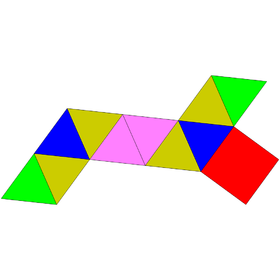| Biaugmented triangular prism | |
|---|---|
 | |
| Type | Johnson J49 – J50 – J51 |
| Faces | 10 triangles 1 square |
| Edges | 17 |
| Vertices | 8 |
| Vertex configuration | |
| Symmetry group | |
| Properties | convex |
| Net | |
 | |

In geometry, the biaugmented triangular prism is a polyhedron constructed from a triangular prism by attaching two equilateral square pyramids onto two of its square faces. It is an example of Johnson solid. It can be found in stereochemistry in bicapped trigonal prismatic molecular geometry.
Construction
The biaugmented triangular prism can be constructed from a triangular prism by attaching two equilateral square pyramids onto its two square faces, a process known as augmentation. These pyramids covers the square face of the prism, so the resulting polyhedron has 10 equilateral triangles and 1 square as its faces. A convex polyhedron in which all faces are regular polygons is Johnson solid. The biaugmented triangular prism is among them, enumerated as 50th Johnson solid .
Properties
A biaugmented triangular prism with edge length has a surface area, calculated by adding ten equilateral triangles and one square's area: Its volume can be obtained by slicing it into a regular triangular prism and two equilateral square pyramids, and adding their volumes subsequently:
It has three-dimensional symmetry group of the cyclic group of order 4. Its dihedral angle can be calculated by adding the angle of an equilateral square pyramid and a regular triangular prism in the following:
- The dihedral angle of a biaugmented triangular prism between two adjacent triangles is that of an equilateral square pyramid between two adjacent triangular faces,
- The dihedral angle of a biaugmented triangular prism between square and triangle is the dihedral angle of a triangular prism between the base and its lateral face,
- The dihedral angle of an equilateral square pyramid between a triangular face and its base is . The dihedral angle of a triangular prism between two adjacent square faces is the internal angle of an equilateral triangle . Therefore, the dihedral angle of a biaugmented triangular prism between a square (the lateral face of the triangular prism) and triangle (the lateral face of the equilateral square pyramid) on the edge where the equilateral square pyramid is attached to the square face of the triangular prism, and between two adjacent triangles (the lateral face of both equilateral square pyramids) on the edge where two equilateral square pyramids are attached adjacently to the triangular prism, are
- The dihedral angle of a biaugmented triangular prism between two adjacent triangles (the base of a triangular prism and the lateral face of an equilateral square pyramid) on the edge where the equilateral square pyramid is attached to the triangular prism, is:
Appearance
The biaugmented triangular prism can be found in stereochemistry, as a structural shape of a chemical compound known as bicapped trigonal prismatic molecular geometry. It is one of the three common shapes for transition metal complexes with eight vertices other than the chemical structure other than square antiprism and the snub disphenoid. An example of such structure is plutonium(III) bromide PuBr3 adopted by bromides and iodides of the lanthanides and actinides.
References
- Rajwade, A. R. (2001). Convex Polyhedra with Regularity Conditions and Hilbert's Third Problem. Texts and Readings in Mathematics. Hindustan Book Agency. p. 84–89. doi:10.1007/978-93-86279-06-4. ISBN 978-93-86279-06-4.
- ^ Berman, Martin (1971). "Regular-faced convex polyhedra". Journal of the Franklin Institute. 291 (5): 329–352. doi:10.1016/0016-0032(71)90071-8. MR 0290245.
- Francis, Darryl (August 2013). "Johnson solids & their acronyms". Word Ways. 46 (3): 177.
- Johnson, Norman W. (1966). "Convex polyhedra with regular faces". Canadian Journal of Mathematics. 18: 169–200. doi:10.4153/cjm-1966-021-8. MR 0185507. S2CID 122006114. Zbl 0132.14603.
- Wells, A. F. (1984). Structural Inorganic Chemistry (5th ed.). Oxford University Press. p. 78–79, 420–423. ISBN 978-0-19-965763-6.


 .
.
 has a surface area, calculated by adding ten equilateral triangles and one square's area:
has a surface area, calculated by adding ten equilateral triangles and one square's area:
 Its volume can be obtained by slicing it into a regular triangular prism and two equilateral square pyramids, and adding their volumes subsequently:
Its volume can be obtained by slicing it into a regular triangular prism and two equilateral square pyramids, and adding their volumes subsequently:



 . The dihedral angle of a triangular prism between two adjacent square faces is the
. The dihedral angle of a triangular prism between two adjacent square faces is the  . Therefore, the dihedral angle of a biaugmented triangular prism between a square (the lateral face of the triangular prism) and triangle (the lateral face of the equilateral square pyramid) on the edge where the equilateral square pyramid is attached to the square face of the triangular prism, and between two adjacent triangles (the lateral face of both equilateral square pyramids) on the edge where two equilateral square pyramids are attached adjacently to the triangular prism, are
. Therefore, the dihedral angle of a biaugmented triangular prism between a square (the lateral face of the triangular prism) and triangle (the lateral face of the equilateral square pyramid) on the edge where the equilateral square pyramid is attached to the square face of the triangular prism, and between two adjacent triangles (the lateral face of both equilateral square pyramids) on the edge where two equilateral square pyramids are attached adjacently to the triangular prism, are 
